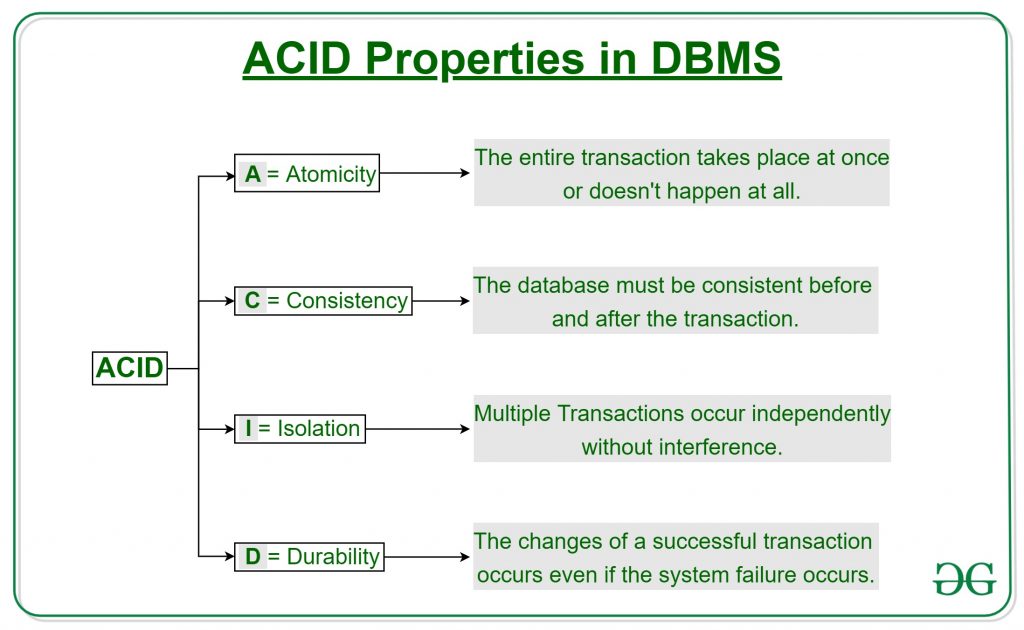In the realm of data management, acid property databases stand as the cornerstone of ensuring data reliability and consistency. These databases adhere to the ACID (Atomicity, Consistency, Isolation, Durability) properties, providing a robust foundation for critical business applications.
Delving into the intricacies of acid property databases, this guide explores their structure, data management practices, and diverse applications. By understanding the strengths and limitations of these databases, organizations can harness their power to safeguard data integrity and empower informed decision-making.
Database Design: Acid Property Database
An acid property database adheres to the ACID principles of atomicity, consistency, isolation, and durability, ensuring data integrity and reliability. Its structure typically consists of tables, each representing a specific entity or aspect of the data.
Common tables include:
- Property table: Stores property-related information, such as address, square footage, and number of bedrooms.
- Owner table: Contains details about property owners, including name, contact information, and ownership stake.
- Transaction table: Records property transactions, including purchase price, date of sale, and buyer/seller information.
Fields within these tables may include:
- Property ID: Unique identifier for each property.
- Street address: Physical location of the property.
- Owner ID: Foreign key linking to the Owner table.
- Transaction ID: Unique identifier for each transaction.
- Purchase price: Amount paid for the property during a transaction.
Data integrity is maintained through referential constraints, which enforce relationships between tables. For example, a foreign key constraint between the Property table and the Owner table ensures that each property has at least one associated owner.
Data Management
Data management in an acid property database involves processes to ensure data accuracy, consistency, and availability. Transactions play a crucial role in this, guaranteeing that data modifications are either fully completed or not applied at all, preserving data integrity.
Database performance can be optimized through techniques such as:
- Indexing: Creating indexes on frequently queried fields to improve search efficiency.
- Caching: Storing frequently accessed data in memory for faster retrieval.
- Query optimization: Using efficient query techniques to minimize resource consumption.
Data loss can be minimized through:
- Regular backups: Creating copies of the database at specified intervals.
- Replication: Maintaining multiple copies of the database on different servers for redundancy.
- Failover mechanisms: Configuring the system to automatically switch to a backup database in case of a primary database failure.
Applications

Acid property databases are widely used in critical business applications where data integrity and reliability are paramount, such as:
- Banking and finance: Managing financial transactions, customer accounts, and regulatory compliance.
- Healthcare: Storing patient records, medical history, and billing information.
- Government: Maintaining land registry, property ownership records, and tax data.
- E-commerce: Processing online orders, managing customer accounts, and tracking inventory.
These databases support mission-critical processes by ensuring data accuracy, consistency, and availability, minimizing the risk of data loss or corruption.
Comparison with Other Database Models
Acid property databases differ from other database models in terms of their strengths and weaknesses:
| Feature | Acid Property Databases | NoSQL Databases |
|---|---|---|
| Data consistency | Guaranteed through ACID principles | Eventual consistency or no guarantees |
| Scalability | Limited by ACID constraints | High scalability due to distributed architecture |
| Flexibility | Less flexible due to schema constraints | More flexible with dynamic schemas |
| Suitable applications | Critical business applications requiring high data integrity | Big data, unstructured data, and high-volume applications |
The choice between acid property databases and NoSQL databases depends on the specific requirements of the application, considering factors such as data integrity, scalability, and flexibility.
Last Word
As the digital landscape continues to evolve, acid property databases remain indispensable for organizations that prioritize data integrity and business continuity. Their ability to maintain data consistency, prevent data loss, and support mission-critical applications makes them an invaluable asset in today’s data-driven world.
Question & Answer Hub
What are the key benefits of using acid property databases?
Acid property databases offer numerous benefits, including guaranteed data consistency, protection against data loss, support for complex transactions, and enhanced data security.
How do acid property databases differ from other database models?
Acid property databases prioritize data integrity and consistency, while other models, such as NoSQL databases, may prioritize flexibility and scalability. The choice between these models depends on the specific requirements of the application.
The Acid Property Database provides valuable information for real estate professionals. It can help you research properties, find comparable sales, and estimate values. If you’re considering getting a commercial real estate loan, it’s important to do your research and understand the process.
You can find helpful information on how to get commercial real estate loans here . Once you’ve gathered all the necessary information, you can use the Acid Property Database to help you make informed decisions about your real estate investments.
What are some common applications of acid property databases?
Acid property databases are widely used in various applications, including banking and financial systems, healthcare management, inventory control, and e-commerce platforms.